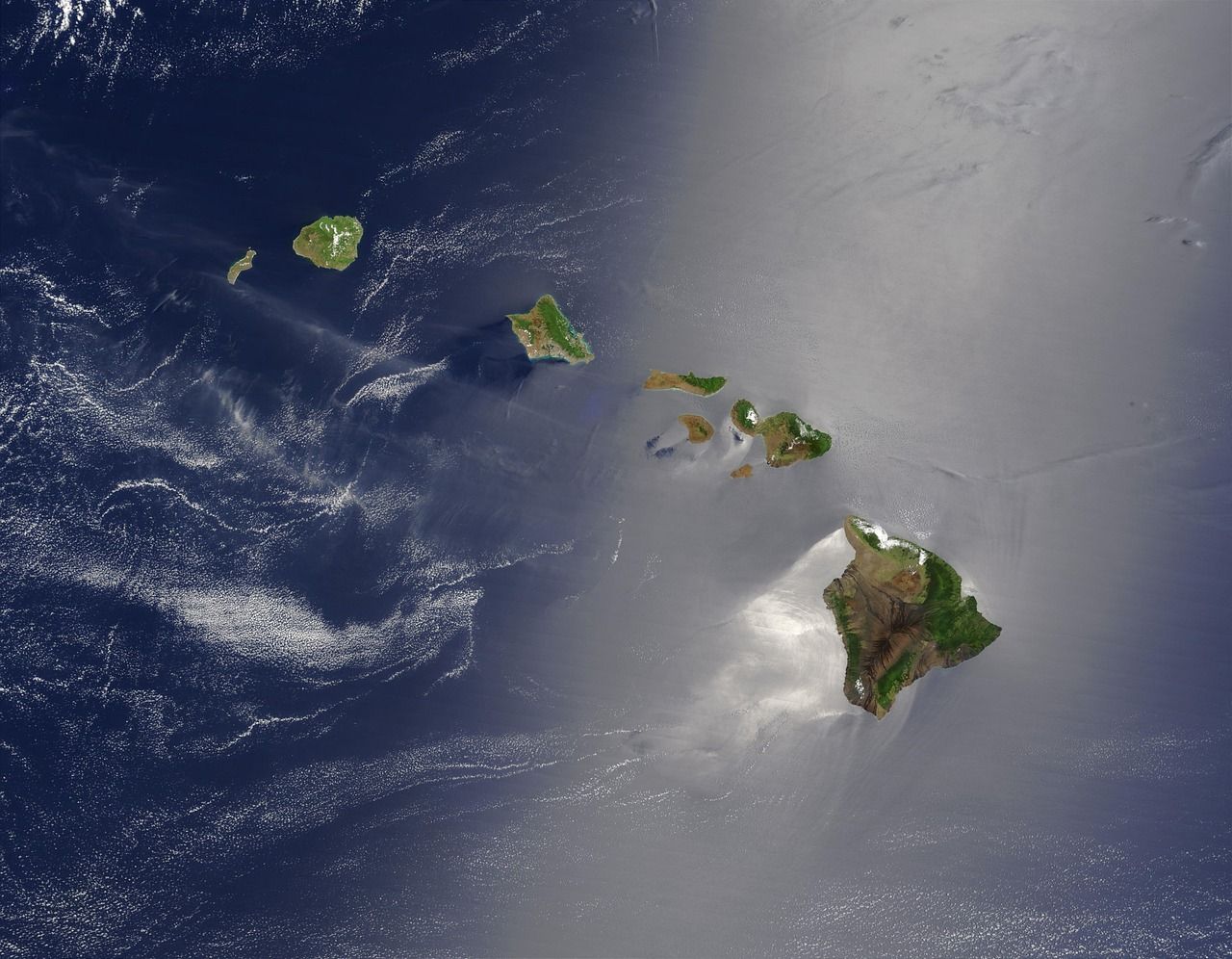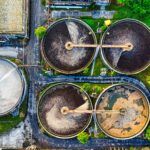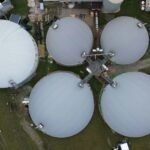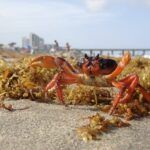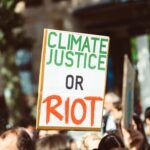Despite their reputation for pristine environments, islands around the world — from Hawai‘i and the Caribbean to those in the South Pacific and the Mediterranean — face growing challenges concerning air qualityAir quality refers to the state of the air we breathe and its composition in terms of pollutants present in the atmosphere. It is considered good when poll...
Read more. A global study by IQAir highlights that only a handful of island territories (including New Zealand, Australia, Iceland, and certain Caribbean islands) currently maintain pollutant levels below WHO-recommended limits. Meanwhile, most islands are already experiencing critical increases in PM2.5 and other atmospheric compounds due to pollution from both local and global sources, such as maritime transport and fossil-fuel combustion.
In the Caribbean, nine out of twenty-three territories have seen increased pollution levels since 2024. In Hawai‘i, where episodes of vog (volcanic smogSmog, beyond that dense fog
Smog is a mixture of air pollutantsAir pollution caused by atmospheric contaminants is one of the most critical and complex environmental problems we face today, both because of its global r...
Read more that accumulate in the atmosphere, especially in urban areas. This phenomenon is character...
Read more) and the arrival of airborne pollutants carried by winds from Asia are becoming more frequent, advanced sensor systems are needed for continuous monitoring. Likewise, in South Pacific islands such as Vanuatu and Fiji, growing levels of pollutants linked to maritime traffic and long-range combustion have already been recorded.
However, new air quality monitoringControlling air quality is an essential task in order to enjoy optimal environmental conditions for healthy human development and to keep the environment i...
Read more technologies, such as advanced sensor networks and predictive analysis systems, are being deployed in ports like Nassau, enabling real-time tracking of airborne pollutant compounds and allowing for a rapid response when dangerous pollution peaks occur.
This article examines the global trend showing that scientific monitoring and technological development are closely connected, as they are the key to understanding and protecting air quality in island environments. It explores the importance of air quality in islands and remote destinations, the implications of polluted air for biodiversity and sustainable tourism, and how new monitoring technologies can help safeguard these unique ecosystems. International cooperation to monitor air quality on islands and the adoption of advanced monitoring technologies are emerging trends in 2025 — and the foundation for strategic action to preserve island paradises.
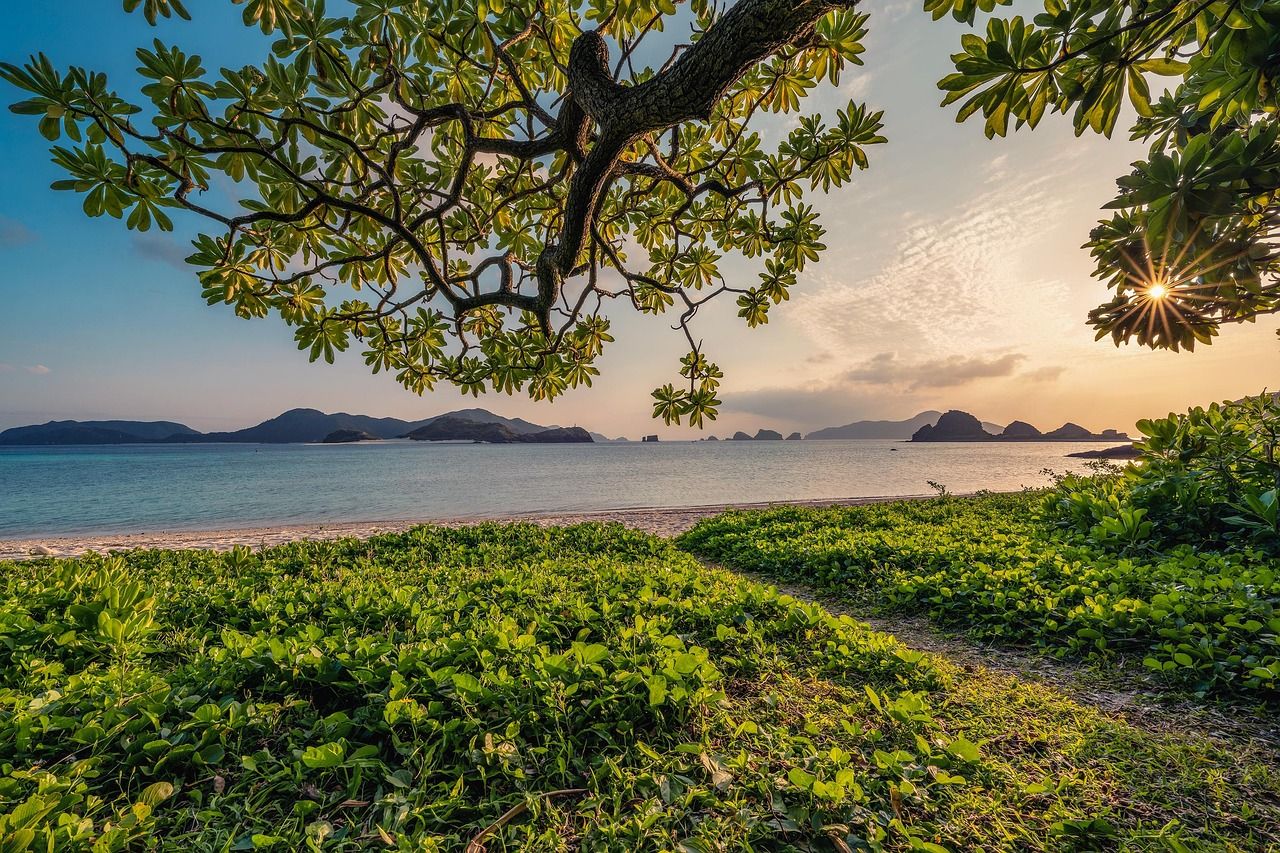
Native vegetation on the island’s coast.
Why air quality matters in island and remote environments
Island systems are characterised by high ecological vulnerability and a limited capacity for resilience and adaptation to environmental disturbances. Due to their geographic configuration, these territories function as partially closed atmospheric systems with low air renewal rates and limited pollutant dispersion. This unique condition promotes the accumulation of anthropogenic emissions from sources such as port activity, land transport, and power generation.
Islands as fragile ecosystems
The atmospheric composition of islands is influenced by the interaction between anthropogenic pressures from human activity and local meteorological variables. Under stable atmospheric or thermal inversion conditions, the vertical mixing capacity of the air decreases, leading to pollutant build-up near the surface. This phenomenon raises concentrations of nitrogen oxides (NOx), sulphur dioxide (SO2)Sulphur dioxide (SO2) is a colourless gas with a pungent odour that causes an irritating sensation similar to shortness of breath. Its origin is anthropoge...
Read more, and particulate matter (PM10, PM2.5), with negative implications for public health, terrestrial biodiversity, and marine ecosystems.
Air Quality Innovation in Just 1 Click
Stay informed about the air you breathe!
Subscribe to our newsletter to receive the latest updates on environmental monitoring technology, air quality studies, and more.
Air pollution in remote and tropical island areas
On small and remote islands, energy systems often rely heavily on the combustion of fossil fuels. This energy dependency results in the emission of significant quantities of greenhouse and air pollutants. The situation is worsened by intense maritime and air traffic linked to tourism, which further adds to the atmospheric burden of harmful compounds. The limited land area and weak air circulation hinder pollutant dispersion, amplifying their environmental impact.
Even in geographically isolated territories, significant concentrations of air pollutants such as tropospheric ozone (O3)Tropospheric ozone (O3) or ground-level ozone is a gas found in the lowest layer of the Earth's atmosphere, the troposphere, which extends up to 10 kilomet...
Read more, fine particulate matter (PM2.5), nitrogen dioxide (NO2)Nitrogen dioxide (NO2) is a harmful gas whose presence in the atmosphere is mainly due to the use of fossil fuels in combustion vehicles and industrial act...
Read more, and ammonia (NH3)Invisible yet powerful: ammonia (NH3) is a colourless gas which, although naturally present in the atmosphere in small amounts, can become an unwelcome ene...
Read more are recorded. The latter plays a key role as a chemical precursor in the formation of secondary particles — ammonium nitrates and sulphates — that affect air quality and visibility. These compounds can be transported over long distances by atmospheric circulation, particularly from high-emission continental areas. Environmental monitoring studies in European and Pacific archipelagos show that geographical isolation does not guarantee clean air, underscoring the need for monitoring and mitigation strategies even in low-impact environments.
As a result, preserving air quality in island environments is a strategic priority due to its environmental, health, and socioeconomic implications. This requires continuous monitoring systems, the promotion of clean energy technologies, and the adoption of sustainable spatial planning models. In these contexts, the atmosphere serves as a critical indicator of ecological balance and of an island system’s resilience capacity.
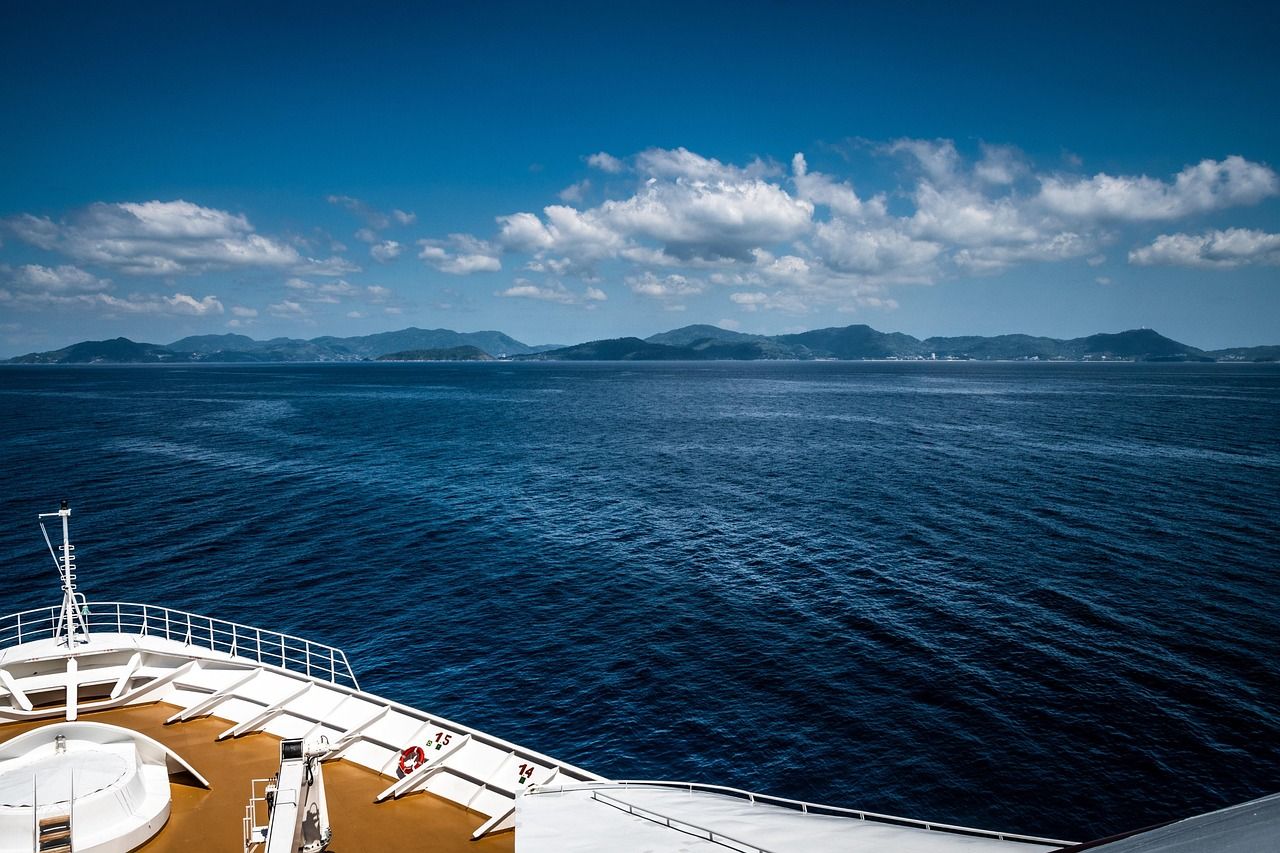
Recreational boat heading towards an island.
Main sources of air pollution on islands
Local emissions: energy, transport, and waste
Islands face a specific environmental challenge due to their dependence on fossil fuels for electricity generation, given limited infrastructure and renewable resources. The burning of petroleum derivatives produces significant emissions of sulphur dioxide (SO2), carbon dioxide (CO2)Carbon dioxide (CO2) is a gas that occurs naturally in the atmosphere and plays a crucial role in the life processes of the planet. This gas, also known as...
Read more, and nitrogen oxides (NOx), greatly contributing to local air pollution. This is compounded by intense maritime and air traffic, particularly linked to tourism, adding further pollutant gases and particulate matter, which affect air quality and increase environmental pressure on fragile island ecosystems.
Energy supply in many regions still depends heavily on fossil fuel combustion for power generation and transport, leading to significant local emissions of nitrogen oxides (NOx), sulphur oxides (SOx) and ammonia (NH3). These emissions not only affect immediate ambient air quality, but also contribute to complex atmospheric processes that generate secondary pollutants such as fine particles, harmful to human health and ecosystems. Managing these local sources is critical to reducing pollutant loads in geographically limited and sensitive areas. USEPA (2016). Integrated Science Assessment for Oxides of Nitrogen, Oxides of Sulfur, and Ammonia.
Another critical contributor to island air pollution is the burning of solid and organic waste — a common practice on many islands due to limited waste management and recycling capacity. This activity releases ammonia (NH3) and other secondary pollutants which, after reacting in the atmosphere, generate persistent fine particles that affect both health and the environment. Agricultural practices, though smaller in scale, also contribute emissions of NH3 and other gases that promote eutrophication and alter soil and water chemistry.
This is the case on several Mediterranean islands such as Mallorca and Ibiza, where rising tourism and the burning of solid waste impact the local atmosphere. The islands’ small size and geographical configuration limit air dispersion, leading to pollutant accumulation and critical episodes during adverse weather conditions.
Other examples of air pollution on islands
Similar phenomena to those observed in the Mediterranean occur in many island regions worldwide. In most cases, poor waste management, intensive agricultural practices, and limited atmospheric dispersion promote the accumulation of pollutants such as ammonia (NH3), nitrogen oxides (NOx) and particulate matter (PM2.5 and PM10). These factors, combined with local weather conditions, generate recurring episodes of poor air quality.
Below are some relevant examples:
Caribbean Islands (Barbados, Guadeloupe, Martinique)
In this region, the burning of solid and plant waste and the use of nitrogen-based fertilisers in sugarcane and banana crops produce significant emissions of ammonia (NH3) and fine particles. The Caribbean Institute for Meteorology and Hydrology (CIMH, 2021) recorded high pollutant concentrations during dry seasons, exacerbated by the transport of Saharan dust, which acts as a chemical catalyst and further reduces regional air quality.
Canary Islands (Spain)
Studies by the Instituto Tecnológico de Canarias (ITC, 2020) and AEMET show that the burning of agricultural and forest residues, combined with frequent dust storms, increases concentrations of particulate matter (PM10 and PM2.5) and ammonia (NH3) in the atmosphere. The archipelago’s complex terrain and frequent temperature inversions limit natural ventilation, promoting pollutant accumulation over urban and tourist areas. Furthermore, concentrated maritime and air traffic associated with tourism increases emissions of NOx and SO2, contributing to frequent episodes of deteriorated urban and peri-urban air quality.
Added to this is the annual intrusion of Saharan dust, which carries not only mineral particles but also anthropogenic pollutants from Europe and North Africa, creating a complex mix of harmful gases and aerosols. This phenomenon parallels that of the Mediterranean, where prevailing winds and regional atmospheric transport facilitate the deposition of industrial and agricultural pollutants on the islands, affecting both local public health and the balance of island ecosystems.
Approximately 20 million tonnes of Saharan dust can be transported to the Caribbean islands each year as a result of North Atlantic trade winds. Garrison et al., 2014; Prospero et al., 2008.
Volcanic gas emissions on islands also pose a major environmental challenge, as volcanic activity releases compounds such as sulphur dioxide (SO2), acidic gases, and particles that can affect human health and local ecosystems. Monitoring in such environments is crucial, since eruptions are unpredictable and island residents are particularly exposed due to their proximity to emission sources. This was the case on the Canary Island of La Palma in 2021, when the volcanic eruption revealed enormous quantities of volcanic gases released into the island atmosphere, with carbon dioxide (CO2) and sulphur dioxide (SO2) emissions that surpassed the annual human emissions of the entire Canary archipelago in just a few weeks.
During this emergency, the intervention of the Spanish Military Emergencies Unit (UME) proved decisive: the deployment of specialised equipment and sensors made it possible to monitor air quality and assess in real time the risks associated with toxic gases, helping to protect the population and ensure a safe return to evacuated areas. Such devices — including those highlighted by Kunak Technologies on the island — were essential for visualising the severity of volcanic impact and ensuring an effective response to this environmental threat.
Hawaii (United States)
In the Hawaiian archipelago, air pollution stems both from the burning of organic and agricultural waste and from volcanic activity. The Hawaii Department of Health (2019) documented that SO2, NH3 and secondary aerosols contribute to episodes of vog (volcanic smog), reducing visibility and affecting respiratory health. These phenomena worsen during periods of low ventilation and high humidity, especially on the islands of Hawai‘i and Maui.
South-East Asian islands (Philippines, Indonesia)
In countries such as the Philippines and Indonesia, the burning of biomass and agricultural residues remains a common practice in rural and island areas. According to the Asian Development Bank (ADB, 2022), these activities generate critical concentrations of ammonia, volatile organic compounds (VOCs) and PM2.5, especially during the dry season. Regional winds transport these pollutants towards coastal and urban areas, impacting public health and tourism activity.
South Pacific islands (Fiji, Samoa)
The Pacific Regional Environment Programme (SPREP, 2020) has noted that reliance on open landfills and limited waste management infrastructure are significant sources of ammonia (NH3) and methane (CH4) emissions. These emissions not only degrade air quality but also contribute to the greenhouse effect and the eutrophication of coastal waters, affecting marine biodiversity.
Taken together, these cases show that island air pollution problems are global, and that the combination of local factors such as limited ventilation, high population density and poor management practices demands the implementation of monitoring networks and integrated sustainability strategies to protect both public health and island ecosystems.
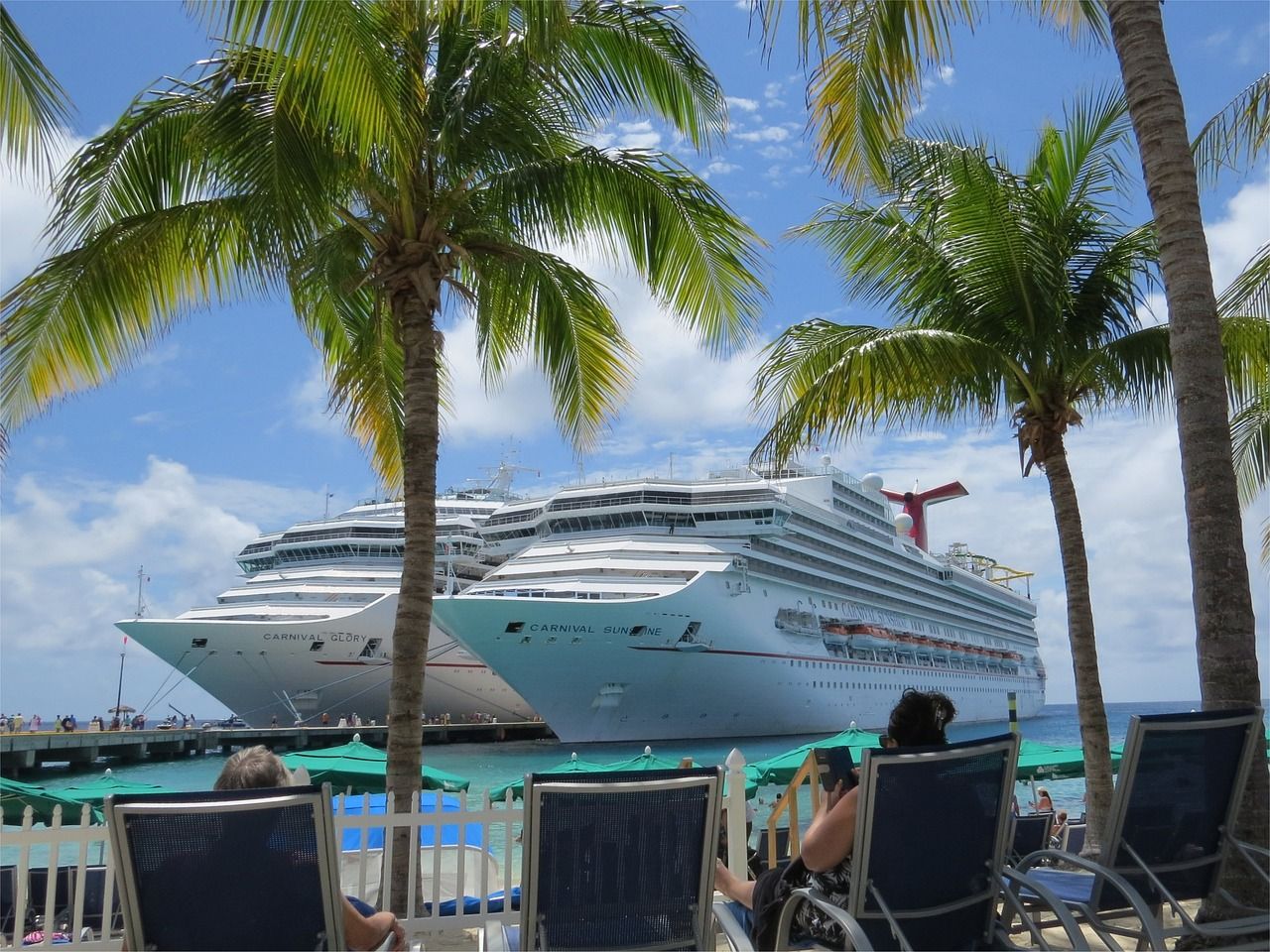
Cruise ships moored at an island.
Imported and long-range pollutants
In island and remote environments, atmospheric pollutants do not only originate from local sources; they can also arrive from distant continents or travel along shipping routes, covering thousands of kilometres before settling in these areas. A prime example of long-range pollution is Saharan dust, which periodically carries mineral particles from the Sahara Desert. These particles, locally known as “calima”, affect air quality and can significantly raise levels of suspended particulates (PM10), with notable impacts on residents’ health as well as on atmospheric visibility.
In addition to mineral dust, industrial aerosols and nitrogen compounds such as ammonia (NH3) and nitrogen oxides (NOx) can also be transported by atmospheric currents from continental industrial or agricultural regions to the islands. Once they reach islands, where pollutant dispersion is limited by geography and meteorological conditions, long-range pollutants add to local emissions, increasing the pollution load and causing critical episodes of poor air quality.
Collectively, these long-distance transport processes highlight the importance of regional and international cooperation in air quality management, since islands, despite their geographical isolation, are not exempt from the consequences of global pollution.
Volcanic emissions and their impact on island air quality
Volcanic activity is a significant natural source of air pollution in many archipelagos worldwide. Gases such as sulphur dioxide (SO2), carbon dioxide (CO2), hydrogen fluoride (HF) and hydrogen sulphide (H2S) are released during eruptions or passive degassing phases, altering air composition and generating phenomena such as acid rain or the well-known vog (volcanic smog).
In regions such as the Canaries, Hawai‘i and Iceland, prolonged exposure to these gases affects both respiratory health and atmospheric visibility, impacting tourism and local economic activities. In addition, volcanic ash particles can combine with anthropogenic pollutants, amplifying their effects on air quality and solar radiation.
For these reasons, continuous environmental monitoring networks are essential for quantifying these emissions, assessing risks and issuing early warnings. Integrating gas sensors for volcanic compounds into systems such as Kunak AIR Pro makes it possible to analyse both natural and human sources of pollution together, providing a comprehensive picture of air quality in island environments.

Gaviotas y paseo turístico en litoral insular.
Impact on biodiversity and sustainable tourism
Effects on biodiversity hotspots
Many islands are true biodiversity hotspots, hosting a great wealth of biological diversity with endemic species. However, many of their ecosystems are highly vulnerable to air pollution. For example, the presence of elevated levels of tropospheric ozone (O3) and suspended particles (PM2.5, PM10) can cause significant damage to native vegetation, affect coral reefs, and alter the composition and activity of soil microorganisms — organisms that are fundamental to the ecological balance of island environments.
In the Canary Islands, for instance, the increase in suspended particles, mainly from Saharan dust and transboundary industrial pollution from North Africa, in addition to local emissions and sea salt, has generated a direct impact on terrestrial and marine biodiversity, as evidenced by the Canary Islands Air Quality Laboratory (AirCanLab). According to research, these episodes increase normal pollutant concentrations by up to twentyfold, affecting the most fragile island ecosystems and posing major challenges for biodiversity conservation.
The WHO global air quality guidelines recommend that the annual mean concentrations of PM2.5 should not exceed 5 µg/m³, those of PM10 15 µg/m³, and the seasonal mean of O3 should not exceed 60 µg/m3 in order to minimize risks to human health and the impact on natural ecosystems. Recent studies show that even small reductions in exposure to these pollutants can lead to substantial benefits for health and biodiversity, since adverse effects are observed even at levels below traditional thresholds. World Health Organization (WHO) 2021. WHO global air quality guidelines.
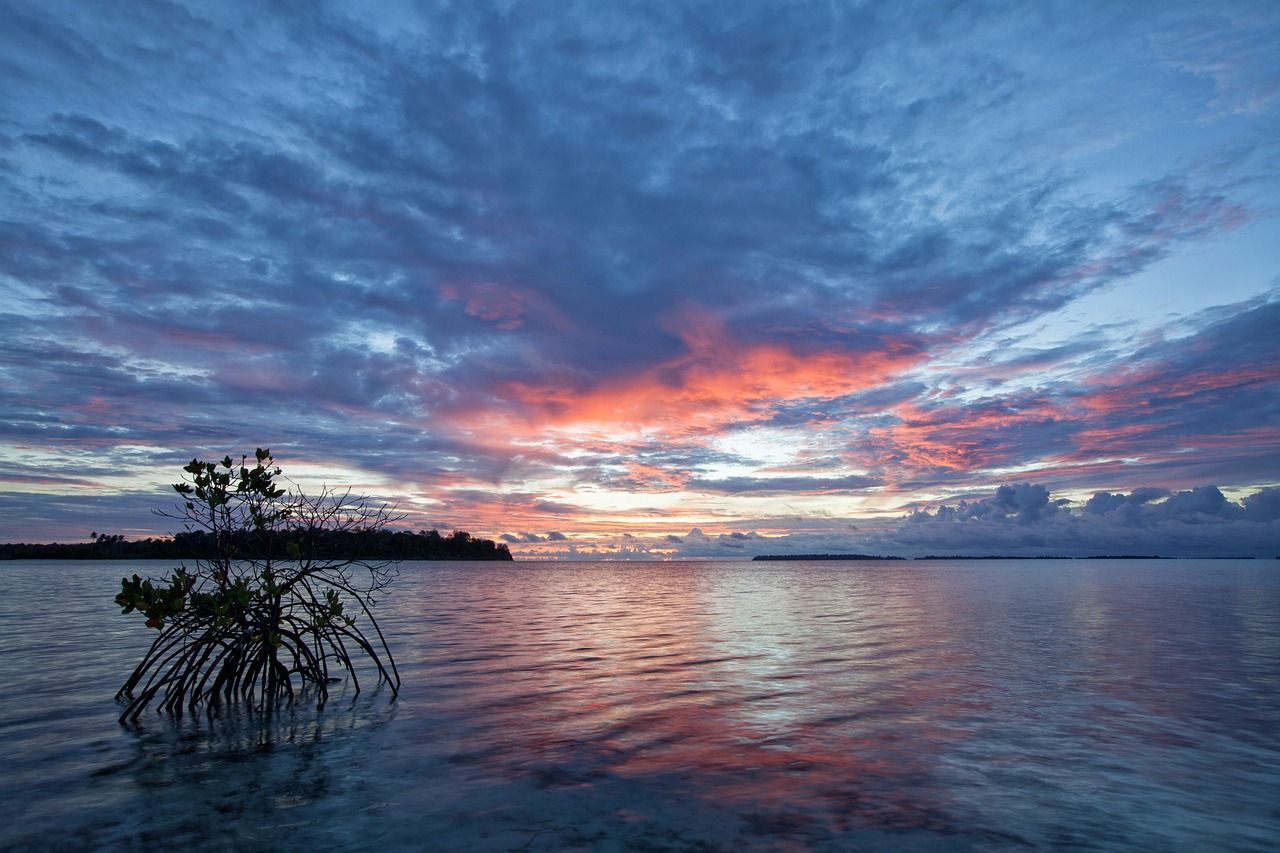
Mangrove swamp on the island coast at sunset
Sustainable tourism and air pollution
From a tourism perspective, air quality is a key factor for sustainability. Healthy ecosystems not only preserve the natural wealth that attracts visitors, but poor air quality can diminish the perception of the environment, reduce its appeal, and increase health risks for both residents and tourists. Therefore, ensuring and improving environmental quality on islands is vital to preserve their unique tourist attractions, protect biodiversity, and sustain the economic viability of tourism-based economies.
Tourism is the main economic activity in most island regions. However, intensive tourism increases emissions from transport, energy production, and waste generation. The demand for clean-air destinations and eco-friendly travel is growing in the tourism sector, as travellers increasingly seek more sustainable experiences.
In recent years, the massive accumulation of sargassum along tropical island coasts has added a new environmental challenge that directly affects tourism sustainability and air quality, generating unpleasant odours. As sargassum decomposes, it emits toxic gases such as hydrogen sulphide and ammonia, which degrade the environmental perception of tourist destinations, affect the health of residents and visitors, and harm coastal ecosystems and local biodiversity. Moreover, the presence of sargassum reduces the attractiveness of beaches, leading to a decline in tourist arrivals and impacting the regional economy.
In response to these impacts on biodiversity and tourism sustainability, technological solutions such as the Kunak AIR Pro monitoring stations provide continuous and precise measurement of air pollutants, supporting local policies that promote more sustainable tourism and cleaner air for island residents and visitors who seek to fully enjoy the beauty of island destinations.

Sargasso toxic gas monitoring by Kunak in the Caribbean for environmental and tourism protection
Air quality monitoring and measurement in remote islands
In island and remote environments, accurate and continuous air quality monitoring is essential to understand and manage atmospheric pollution.
Traditional methods versus smart systems
Conventional air quality monitoring methods, such as passive samplers or gas chromatography, offer high analytical precision. However, they present significant limitations, including the need for regular maintenance and the inability to provide real-time data — critical aspects in areas where access and logistics are challenging.
In contrast, advanced environmental monitoring systems based on IoT technologies, such as Kunak monitoring stations, provide an optimal solution for island settings. These stations enable high temporal resolution in data capture, offering continuous, real-time monitoring of a wide range of air pollutants such as CO, NO2, SO2, NH3, ozone, and particulate matter (PM1, PM2.5, PM10), as well as key meteorological parameters including temperature, humidity, and atmospheric pressure.
One of the key advantages of Kunak stations is their innovative smart cartridge system, which allows for remote calibration, low energy consumption, and high durability. It also simplifies maintenance thanks to a plug & play design that enables easy cartridge replacement without the need for factory servicing — ideal for deployment in isolated regions. This prevents interruptions in monitoring and ensures reliable, continuous data to support environmental decision-making.

When floating in the ocean, sargassum is a source of food, shelter and reproduction for marine life, but on the shoreline it poses a threat to coastal ecosystems.
Case study: assessing air quality on a remote island
Monitoring air quality on tropical islands is essential to accurately identify the specific sources of pollution affecting these unique environments. Such studies make it possible to quantify both the direct and indirect effects of air pollution on environmental quality, sustainable tourism, and local public health.
They also provide a solid foundation for designing effective environmental management strategies tailored to the specific needs of each island. Kunak’s smart sensors are ideal for these projects, as they can collect reliable, real-time data even in remote and hard-to-reach locations, enabling continuous and detailed monitoring of the pollutants present.
Sargassum: environmental challenges and impact monitoring
A practical example of this technology is the study on the environmental impact of sargassum on tropical coasts, where monitoring carried out with Kunak stations has been key to assessing atmospheric conditions and helping to mitigate related environmental issues. This project has shown how advanced technology can contribute to more efficient management of complex environmental challenges in island regions.
Oceanic air pollution study: Gwad’Air
Another relevant case is the air pollution study conducted by Atmo Guadeloupe (Gwad’Air), the regional authority for air quality monitoring and control in Guadeloupe (French Caribbean), a member of the national ATMO France federation.
In this project, Kunak AIR Pro stations were used to analyse the influence of local and long-range pollution sources on air quality, based on the detection of atmospheric pollutants over the ocean. The collected data provided essential insights for public health decision-making and the development of environmental policies, highlighting the crucial role of advanced monitoring in ensuring sustainability and environmental protection in remote islands.

Island lighthouse and starry sky.
Frequently Asked Questions (FAQs)
Why do remote islands face air pollution problems?
Air pollution issues on islands are mainly caused by two factors: they receive pollutants transported by atmospheric circulation from distant sources (such as mineral dust, industrial aerosols, and nitrogen compounds), and they also generate local emissions through fossil fuel-based energy production, maritime and air traffic connecting these territories, and tourism-related activities.
How does air pollution affect tropical biodiversity?
Air pollutants harm tropical biodiversity by affecting terrestrial and marine plant and animal species. Ozone (O3) can cause leaf necrosis and reduce plant fertility, while nitrogen deposition (NH3, NO2) alters nutrient balance and encourages the spread of invasive species. Fine particles (PM2.5 and PM10) impact the respiratory health of local fauna and flora and can modify soil microorganism structures, disrupting essential ecological exchange processes with the environment.
Can sustainable tourism improve air quality?
Sustainable tourism promotes environmentally responsible practices such as the use of renewable energy, electric mobility, and efficient waste reduction and management. These measures help minimise local pollutant emissions, contributing to improved air quality and preserving natural environments — which is essential for ecosystem health and the long-term attractiveness of island destinations.
What tools are available to measure air quality on remote islands?
There are IoT-based environmental monitoring systems, such as the Kunak AIR Pro station and its smart GasPlug cartridge system, which provide continuous, accurate measurements and traceable real-time data for multiple pollutants. These technologies enable sensor deployment in isolated locations with low maintenance requirements and autonomous operation thanks to solar panels, allowing the collection of reliable data to support environmental management and informed decision-making.
Which pollutants are most relevant in island environments?
The main pollutants in island environments are ammonia (NH3), nitrogen dioxide (NO2), ozone (O3), sulphur dioxide (SO2), and particulate matter PM2.5 and PM10. These pollutants can originate from both local sources and long-range transport, and their cumulative effects in island atmospheres cause harm to human health, biodiversity, and ecosystems.
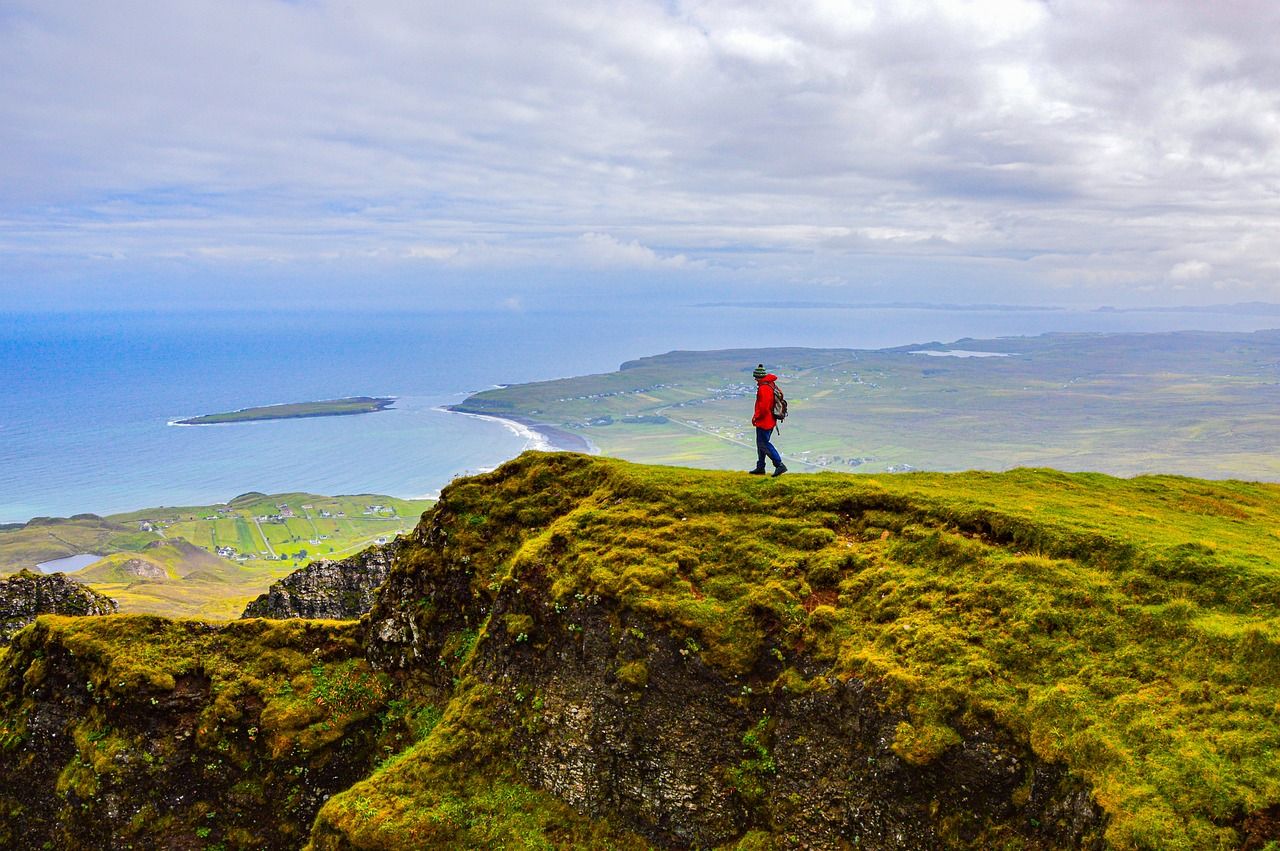
Coast of an island.
Conclusion
Air quality on islands and in remote environments represents a strategic challenge for environmental management and biodiversity protection, as well as for safeguarding the health of both residents and visitors. Island ecosystems are subject to intense environmental pressures arising from both local and external sources, sometimes located far beyond their borders.
This situation is exacerbated by their limited atmospheric dispersion capacity and the presence of endemic species highly sensitive to pollutants. Emissions from energy production, transport, and waste management, together with the recurrent arrival of long-range pollutants (such as Saharan dust and industrial aerosols), create a complex exposure pattern for islands that can seriously affect both human health and fragile island ecosystems.
Ensuring environmental quality in these territories requires continuous, accurate, and adaptive monitoring tailored to each island’s specific needs, as demonstrated by networks of smart monitoring stations and pioneering research projects in the Canary Islands and other island regions. The data collected make it possible to identify pollution sources, assess impacts on biodiversity, and guide effective environmental and public health measures, which are crucial to maintaining economic stability based on sustainable tourism and the conservation of natural resources.
Ultimately, only through an integrated approach, built on advanced technology and international cooperation, will it be possible to preserve the uniqueness and resilience of these admired island enclaves. Protecting both their inhabitants and their extraordinary natural heritage means tackling the challenges of climate change and air pollution.
References and scientific sources
- Behera, S. N., Sharma, M., Aneja, V. P., & Balasubramanian, R. (2013). Ammonia in the atmosphere: a review on emission sources, chemistry and deposition. Environmental Science and Pollution Research, 20(11), 8092–8131. https://pubmed.ncbi.nlm.nih.gov/23982822/
- European Environment Agency (EEA). (2022). Air pollution and NH3 emissions report. https://www.eea.europa.eu/en/analysis/indicators/emissions-of-air-pollutants-from
- United States Environmental Protection Agency (EPA). (2016). Integrated science assessment for oxides of nitrogen, oxides of sulfur, and ammonia. https://www.epa.gov/isa/integrated-science-assessment-isa-ecological-criteria-assessment-oxides-nitrogen-oxides-sulfur
- Sutton, M. A. et al. (2013). The European Nitrogen Assessment: Sources, Effects and Policy Perspectives. Cambridge University Press. https://publications.tno.nl/publication/34627916/9cz42o/b11009.pdf
- Shairsingh, K. K., Jeong, C. H., & Evans, G. J. (2019). Transboundary and traffic influences on air pollution across two Caribbean islands. Science of The Total Environment, Volume 653. https://doi.org/10.1016/j.scitotenv.2018.11.034
- World Health Organization (WHO). (2021). WHO Global Air Quality Guidelines: Particulate matter (PM2.5 and PM10), ozone, nitrogen dioxide, sulphur dioxide and carbon monoxide. https://www.who.int/publications/i/item/9789240034228
